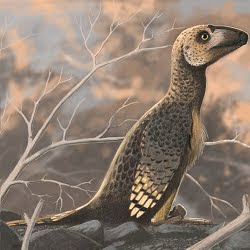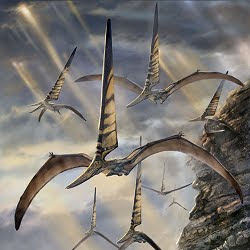Při obnovování blogu jsem napsal, že "není špatný nápad shromažďovat paleo-abstrakty na jednom místě, většina z nich však nebude překládána a budu je sestavovat do okomentovaných, např. týdenních nebo dvoutýdenních přehledů aktualit". Nyní je první zástupce takového druhu článků tady.
Vybíral jsem výhradně z abstraktů, které na DML v posledních dnech umístil Jerry Harris, ne nadarmo nazývaný autory kompendia The Dinosauria "Wunderkind of dinosaur bibliophily". Abstraktům, které popisují objev nového druhu - jde konkrétně o jednoho pterosaura, jednoho enantiornitha a v záloze zbývá několik nových avšak dosud nezmíněných neptačích dinosaurů - se budu věnovat v samostatných článcích. Stejně to bude se studií o apatosaurově neuroanatomii, která je volně dostupná a samostatný článek si jistě zaslouží také. Vynechal jsem i studie, které se pan-avianů nijak přímo nedotýkaly a věnovaly se místo toho druhohorní paleoklimatologii nebo geologii.
Máme zde tedy tafonomickou revizi aljašských dinosarů ze svrchnokřídového souvrství Prince Creek, revizi geografického výskytu teropodů z mexického státu Coahuila a Zhouvu práci o novém materiálu pterosaura elanodaktyla, zdůrazňující jeho autapomorfie.
Možná vůbec nejzajímavější jsou však tentokrát studie týkající se žijích pan-avianů, konkrétně ratitů (běžců) a alkounů. První práce dokládá, že tinamy tvoří mezi paleognathními ptáky monofyl s gigantickými vymřelými nelétavými ptáky moa z Nového Zélandu, což znamená, že ke ztrátě letu muselo mezi ratity dojít několikrát nezávisle na sobě a že tinamy nejsou proti hlavní dnes respektované fylogenetické hypotéze sesterským kladem ratitů, ale jeho součástí. Autoři tím pozoruhodně navazují na Harshmanovu fylogenomickou studii, o které jsem na starší verzi blogu psal předminulý rok. Pokud by tato fylogenetická hypotéza - která je však stále sporná, jak je patrné dokonce i z popisu příslušné analýzy v abstraktu - získala širší podporu, mohlo by si to vyžádat změnu definic jak jména Ratitae, tak i Tinamidae. V současné podobě jsou za ratity označeny ty druhy, které jsou blíže příbuzné pštrosu dvouprstému než tinamě větší a kondorovi velkému, a za tinamy zas druhy blíže příbuzné tinamě větší než pštrosovi dvouprstému a kondorovi velkému. Autoři si všímají také geografických implikací: jejich hypotéza je úspornější v tom, že nepotřebuje řetězy ostrovů pro sladění evoluce ptáků s rozpadem kontinentů. Nicméně je stále třeba zachovat určitou míru skepticismu, autoři svou hypotézu odvodili z non-kladistických, spíše fenetiku připomínajících metod.
Práce týkající se alkounů se zaměřuje na evoluci mechanosenzorické role hřebínku per na čele, kterým tito ptáci disponují. Abstrakt naznačuje, že studie tento účel jednak experimentálně prokázala a jednak přinesla možné vysvětlení pro jeho vznik. První senzorické struktury vznikly v důsledku obydlení složitých prostor, vyžadujících dobrou orientaci v trojrozměrném prostoru, a časem se zvětšily díky pohlavnímu výběru nebo jiným sociálním mechanizmům.
Fiorillo, A. R., McCarthy, P. J. & Flaig, P. P. 2010. Taphonomic and sedimentologic interpretations of the dinosaur-bearing Upper Cretaceous strata of the Prince Creek Formation, northern Alaska: insights from an ancient high-latitude terrestrial ecosystem. Palaeogeography, Palaeoclimatology, Palaeoecology. doi:10.1016/j.palaeo.2010.02.029
Several dinosaurian bonebeds occur within the Campanian-Maastrichtian portion of the Prince Creek Formation of northern Alaska along a 45 km stretch of the Colville River. These beds are characterized by the occurrence of bones from large numbers of juvenile to sub-adult dinosaurs entombed in a hydraulically incompatible fine-grained matrix. The skeletal elements show little evidence for articulation, though there is evidence for association. Further, the bones show little evidence of post-mortem alteration such as prolonged exposure to weathering, predation, or trampling. The sediments of the Late Cretaceous to Paleocene Prince Creek Formation represent a continental succession deposited on a high-latitude, low-gradient alluvial/coastal plain. Deposition occurred in trunk channels, on distributary-channel splay-complexes, in interdistributary bays, and on floodplains. These bonebeds formed under unique paleoclimatic and paleogeographic conditions. Although mean annual temperatures on the coastal plain were higher during the deposition of the Prince Creek Formation than modern temperatures, the evolving Brooks Range orogenic belt formed the southern edge of the Colville basin, providing a high-latitude, cooler alpine environment in close proximity to these warmer lowland environments. Seasonal flow due to the combination of snow melt and alpine permafrost in the ancestral Brooks Range likely produced regularly occurring seasonal floods, which are the likely killing mechanism that resulted in the formation of these bonebeds.
Phillips, M. J., Gibb, G. C., Crimp, E. A. & Penny, D. 2010. Tinamous and moa flock together: mitochondrial genome sequence analysis reveals independent losses of flight among ratites. Systematic Biology 59 (1):90-107.
Ratites are large, flightless birds and include the ostrich, rheas, kiwi, emu, and cassowaries, along with extinct members, such as moa and elephant birds. Previous phylogenetic analyses of complete mitochondrial genome sequences have reinforced the traditional belief that ratites are monophyletic and tinamous are their sister group. However, in these studies ratite monophyly was enforced in the analyses that modeled rate heterogeneity among variable sites. Relaxing this topological constraint results in strong support for the tinamous (which fly) nesting within ratites. Furthermore, upon reducing base compositional bias and partitioning models of sequence evolution among protein codon positions and RNA structures, the tinamou–moa clade grouped with kiwi, emu, and cassowaries to the exclusion of the successively more divergent rheas and ostrich. These relationships are consistent with recent results from a large nuclear data set, whereas our strongly supported finding of a tinamou–moa grouping further resolves palaeognath phylogeny. We infer flight to have been lost among ratites multiple times in temporally close association with the Cretaceous–Tertiary extinction event. This circumvents requirements for transient microcontinents and island chains to explain discordance between ratite phylogeny and patterns of continental breakup. Ostriches may have dispersed to Africa from Eurasia, putting in question the status of ratites as an iconic Gondwanan relict taxon.
Seneviratne, S. S. & Jones, I. L. 2010. Origin and maintenance of mechanosensory feather ornaments. Animal Behaviour 79 (3):637-644.
Mechanosensory use is a seldom-mentioned function for feather ornaments, yet recent experimental evidence showed that the elaborate facial plumes of crevice-dwelling whiskered auklets, Aethia pygmaea, have just such a sensory role. Here we explored the evolutionary patterns of mechanosensory function of similar facial feather ornaments in related species. In an experimental chamber (maze) devoid of visible light, crested auklets, A. cristatella, a close relative of the whiskered auklet, showed an increase in head bumps (262%) after trial flattening of their forehead crest. The frequency of head bumps in the absence of the crest was positively correlated with the natural crest length of the crested auklet. There was no correlation between crest length and head bumps when we added an artificial crest to least auklets, A. pusilla, which do not have a natural crest. Thus, only the ornamented Aethia species that breed in deep-crevice appear to have detectable mechanosensory ability. A pairwise analysis across all nonpasserine bird families further revealed a greater frequency of elongated facial plumes in birds that live in complex habitats and are active during low light conditions. We suggest that selective pressure enforced by complex habitats may trigger facial feather exaggeration for mechanosensory use. Once the primordial sensory structures evolved, sexual and other social selection processes could act on these traits and lead towards further exaggeration.
Torres-Rodríguez, E., Montellano-Ballesteros, M., Hernández-Rivera, R. & Benammi, M. 2010. Dientes de terópodos del Cretácico Superior del Estado de Coahuila, México. Revista Mexicana de Ciencias Geológicas 27 (1):72-83.
In Mexico, the theropods represents a poorly known group of dinosaurs, the scarce material had been referred only to “family” level. As a result of paleontological research carried on in the State of Coahuila, dental remains belonging to theropods were recovered. The identified genera are Saurornitholestes, cf. Troodon, as well as Tyrannosauridae and an indeterminate theropod. The theropod diversity of Coahuila is similar to that described for the Big Bend National Park, Texas, confirming the existence of a distinct dinosaurian biogeographic province in the southern Great Plains of North America. If the presence of Troodon at this latitude is confirmed, it would suggest that the geographic distribution of this theropod genus was much wider than previously supposed.
Zhou, C.-F. 2010. New material of Elanodactylus prolatus Andres Ji, 2008 (Pterosauria: Pterodactyloidea) from the Early Cretaceous Yixian Formation of western Liaoning, China. Neues Jahrbuch für Geologie und Paläontologie - Abhandlungen 255:277-286.
A new specimen of Elanodactylus prolatus Andres & Ji, 2008 is described from the Early Cretaceous Yixian Formation of Chaoyang, western Liaoning, China. The new specimen confirms the validity of E. prolatus and its unexpected feature, unique among pterodactyloids, the first wing phalanx of E. prolatus being shorter than the second and third wing phalanges. Additionally, the specimen provides new information about the pelvic girdle and hind limb: puboischiadic plate with a prominent, tongue-like ventral process; a semicircular prepubis; long and slender metatarsal III; and strongly reduced pedal digit V. Moreover, the elongate second and third wing phalanges possibly represent an independently evolved feature, which convergent on that seen in primitive members of the rhamphorhynchoids. Especially, when combined with recent discoveries of the Anurognathidae, this feature of Elanodactylus further increases the complexity of the pattern of wing phalanx proportions among Pterosauria.











